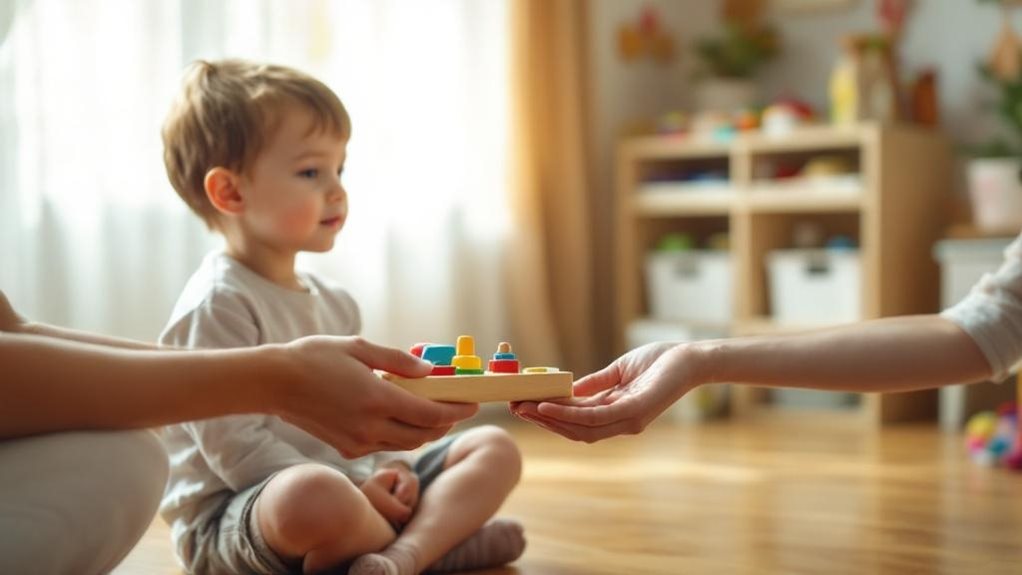Physical Address
304 North Cardinal St.
Dorchester Center, MA 02124
Physical Address
304 North Cardinal St.
Dorchester Center, MA 02124

Want to transform your preschooler's defiant behavior into cooperation using five proven strategies that address the real reasons behind their challenging actions?
You can prevent defiant behavior in preschoolers by establishing predictable daily routines with clear expectations, offering meaningful choices within structured boundaries, and focusing on positive reinforcement rather than punishment. Create supportive environments that address emotional needs proactively, and build your child’s communication skills through active listening and emotion recognition activities. These evidence-based strategies address the root causes of challenging behavior by fostering independence, emotional regulation, and trust—and there’s much more you can discover about implementing each approach effectively.
When preschoolers know what to expect throughout their day, they’re far more likely to cooperate and exhibit positive behaviors. Routine consistency provides the predictable framework children need for healthy social-emotional development and cognitive growth. By establishing clear daily schedules and step-by-step routines, you’re creating an environment where children can anticipate changes and respond appropriately.
Implementing behavioral boundaries requires warm, responsive relationships paired with structured learning environments. Clear communication guarantees children understand expectations, while visual reminders help reinforce routines. When you consistently apply consequences and provide clear signals during changes, you’re supporting children’s independence and confidence.
This predictable structure doesn’t just manage behavior—it fosters security and trust, enabling preschoolers to thrive emotionally while developing self-regulation skills essential for their growth. Teachers should focus on identifying a small number of key behavioral expectations rather than overwhelming children with too many rules at once.
Building on the foundation of predictable routines, offering meaningful choices within structured boundaries empowers preschoolers while maintaining necessary limits. You’ll find that providing two reasonable alternatives reduces power struggles while fostering independence. When you present structured options like “Would you like to wear your red shirt or blue shirt?” you’re teaching decision-making skills within safe parameters.
Choice boards with visual aids help children understand their options and feel more in control. These tools work particularly well during changes, transforming potential conflict into cooperation. Visual aids can turn abstract ideas into concrete concepts, increasing student comprehension and independence. Remember, you’re not offering unlimited freedom—you’re creating opportunities for autonomy within your established framework. This approach respects children’s need for control while maintaining behavioral expectations, ultimately reducing defiance through respectful collaboration rather than rigid commands.
Rather than relying on punishment-based approaches that often escalate defiant behaviors, positive reinforcement creates a powerful foundation for lasting behavioral change in preschoolers. You’ll find that children respond more effectively when their good choices receive immediate recognition and encouragement.
Implement these evidence-based strategies to strengthen positive behaviors:
This approach enhances attention span, memory retention, and problem-solving abilities while creating a constructive classroom atmosphere where children feel valued and motivated. Conducting preference assessments helps ensure that your reinforcement strategies are tailored to what truly motivates each individual child in your classroom.
While positive reinforcement builds the foundation for good behavior, creating supportive physical and emotional environments prevents many challenging behaviors before they occur. Strategic environmental design greatly reduces defiant behaviors by implementing predictable schedules and responsive routines that provide stability. You’ll want to adjust physical spaces to prevent unsafe behaviors while offering multiple sensory activities that engage children constructively.
Equally important is establishing thorough emotional support systems. Use books and pictures to help children label emotions and develop appropriate expression skills. Place children near socially competent peers and provide interactive toys that encourage positive collaboration. Your responsive caregiving should address emotional needs while offering safe exploration opportunities.
When preschoolers can effectively communicate their needs and understand their emotions, defiant behaviors decrease markedly. You’ll find that building these foundational skills requires intentional strategies that promote both emotional awareness and social skills development.
Here are four evidence-based approaches to strengthen communication and emotional intelligence: